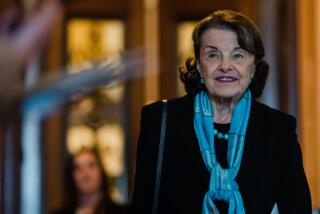Michael Feinstein’s favorite Sinatra tunes
Michael Feinstein was, he says, just a “nobody” some three decades ago when he was hired to play a private birthday party at Chasen’s for Frank Sinatra’s wife, Barbara. But even in his 20s, Feinstein, now 56, was a consummate interpreter of the Great American Songbook.
“I was playing as many obscure songs I could come up with to get [Sinatra’s] attention,” Feinstein said over the phone from his home in New York. “After an hour, he came over to me and said, ‘How do you know all of those songs? How old are you, 12?”’
Sinatra then invited the fresh-faced singer over to his table and, Feinstein recalls, “he told stories. Then I was invited to his house for dinner and became friends. It was fantastic to be able to sit and talk. The music is what mattered to him more than anything.”
LISTEN: 5 essential Frank Sinatra songs
What made Sinatra such an extraordinary singer, said Feinstein, was “the depth to which he approached his art. It is the depth of connection that he brought to his singing. He was involved deeply in the arrangements, the seating of the orchestra [at recordings], in the miking techniques, changing things on the spot to create the perfect sound portrait when he made a record.”
In 2008, Feinstein recorded “The Sinatra Project,” an acclaimed album of both popular and more obscure songs performed by the Chairman of the Board. He followed that last year with “The Sinatra Project, Vol. II.” Feinstein (who takes over the reigns as conductor of the Pasadena Pops Orchestra next summer after the death of his friend Marvin Hamlisch) on Saturday will be performing Sinatra tunes from those albums with a 17-piece big band at the Segerstrom Center for the Arts in Costa Mesa.
Not only has Feinstein kept the Great American Songbook alive through his performances, but he is also a preeminent musical archivist and historian. In 2000, the Library of Congress appointed him to the National Recording Preservation Board. The Michael Feinstein Great American Songbook Initiative, located in Carmel, Ind., revolves around the preservation and exhibition of artifacts relating to the songbook, as well as educating youngsters on the importance of the music. His latest project is the book and CD “The Gershwins and Me: A Personal History in Twelve Songs.”
The Times posed a nearly impossible question to Feinstein: Could he name the his top five Sinatra songs and explain why they mean so much to him? Not surprisingly, Feinstein was more than up to the task.
His five essential Sinatra classics:
“I’ve Got You Under My Skin” (Cole Porter), as recorded in 1956: I love that as much for Nelson Riddle’s arrangement as for the vocal performance. The two are inextirpable. So much of what made Sinatra great was the arrangements. In the case of “I’ve Got You Under My Skin,” I think that is the supreme collaborative example of the best of Nelson Riddle and Frank Sinatra where one fed off the other.
“You Make Me Feel So Young” (music by Josef Myrow, lyrics by Mack Gordon), as recorded in 1956: It’s a song from a [1946] movie called “Three Little Girls in Blue.” It was a delightful movie song, but again with Nelson Riddle’s arrangement, it became another thing entirely. That is an example of where Sinatra’s ‘50s swagger is so perfectly suited to what the song says, reinvigorating a song that was 10 years old and making it absolutely immediate.
“All the Way,” (music by Jimmy Van Heusen, lyrics by Sammy Cahn), as recorded in 1957: It is an eloquent expression of romance. It is the pinnacle of the collaboration between Sammy Cahn and Jimmy Van Heusen. It was written for Sinatra. “All the Way” is a song of yearning, of striving for the affection for another person — that deep need to share your life with someone.
“Fools Rush In,” (music by Rube Bloom, lyrics by Johnny Mercer), recorded in 1940, 1947 and 1960: “Fools Rush In” is something he reinterpreted through the decades. It became much deeper. In his later recording, he goes for a high note that was almost off the charts. I hear that section of the song and it always opens my heart and makes me feel that moment of joy when one realizes another person has transformed their existence.
“Nice ‘n’ Easy” (music by Lew Spence, lyrics by Alan and Marilyn Bergman), recorded in 1960: “It is an example of how he could sing — he could do a medium tempo, laid-back swing performance that just bubbled with energy, but still had a lazy confidence about it. That song in the hands of anybody else would not have had that unspoken gravitas that Sinatra brought to it. On the surface it’s “Hey, babe, what’s your hurry,” but underneath, you feel this woman’s [he’s singing to] goose is cooked!
Michael Feinstein: The Sinatra Project
Where: Segerstrom Center for the Arts, Costa Mesa
When: 7:30 p.m. Saturday
Tickets: $45-$90
Information: (714) 556-2787 or https://www.scfta.org
More to Read
The biggest entertainment stories
Get our big stories about Hollywood, film, television, music, arts, culture and more right in your inbox as soon as they publish.
You may occasionally receive promotional content from the Los Angeles Times.











